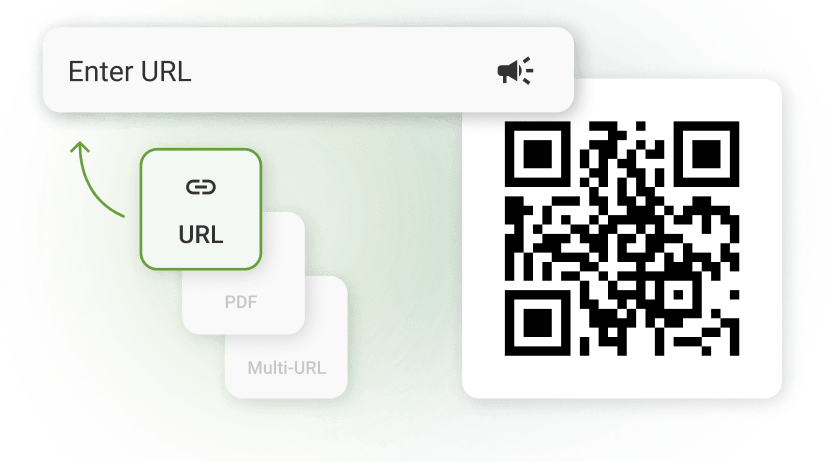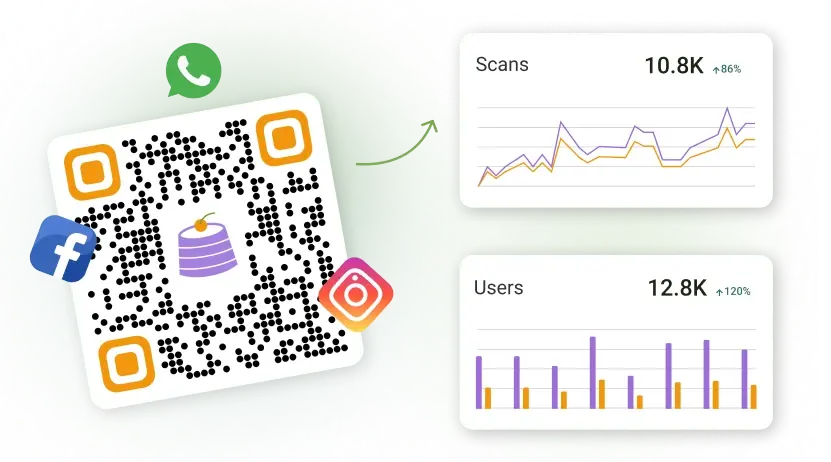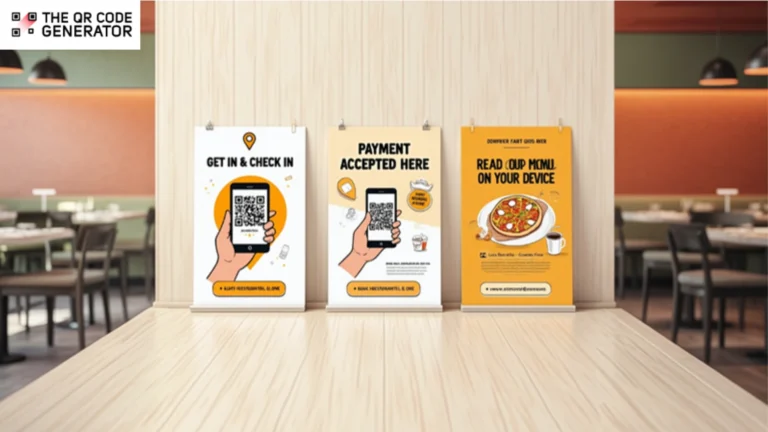Print marketing in the form of promotional flyers is still one of the most effective marketing tools in the food industry. In fact, 89% of people remember flyers better than any other form of advertising. That’s a powerful brand recall that most marketing channels can’t match.
But let’s face it: flyers aren’t cheap. A single black and white print run can cost $200 to $500, which adds up quickly over the year. The real question is: Are they actually driving customers, or just building brand visibility?
In digital marketing, we track every click, conversion, and impression. So why should print campaigns remain a mystery? Flyers may live in the physical world, but that doesn’t mean they can’t deliver digital-level insights.
QR Codes on flyers change the game. They make it possible to measure flyer performance, turning each campaign into a data-driven, ROI-focused effort.
This article will explore the challenges of running untracked flyer campaigns and how QR Codes solve them.
Table of contents
- Why traditional restaurant flyers fall short without QR Codes
- How do QR Codes turn restaurant flyers into measurable ROI tools?
- From paper to profit: Making ROI-friendly QR Code flyers
- Best practices to make QR Code flyers drive real restaurant sales
- Turn flyers into measurable marketing tools with QR Codes
- Frequently asked questions
Why traditional restaurant flyers fall short without QR Codes
In the past, flyers worked as one-way communication: restaurants shared offers, and customers either responded or ignored them. But in today’s data-driven marketing world, that approach leaves big gaps. Flyers without QR Codes hit a ceiling. The physical format alone can’t deliver the insights or interactions modern restaurants need.
Here are some of the biggest challenges with traditional flyers:

1. Generates no measurable data
You might hand out 1,000 flyers, but you never know how many people actually use them. A pizza chain, for example, could share stacks of flyers at a college campus but never learn if those efforts brought students in for a slice. Without measurable data, money goes out with no clear way to track return.
The solution: With QR Codes, every scan shows exactly how many people engaged, giving restaurants real numbers to measure success.
2. Impossible to attribute results to specific campaigns
Traditional flyers blur the lines if you launch a “Kids Eat Free” deal alongside a “Happy Hour” discount. A family may walk in with a flyer, but you cannot tell if they came for the kids’ offer or the drink discount. As a result, you lose the chance to double down on whichever campaign worked better.
The solution: With QR Codes, you can generate separate links for each promotion and instantly see which campaign drove more customers.
3. Can’t measure location or time-based engagement
A café might place flyers at nearby gyms and co-working spaces. Without scan analytics, you cannot compare whether gym-goers picked up more smoothies after workouts or if office workers grabbed quick lunches instead.
The same applies to timing. Flyers given out at 5 PM may perform differently from those handed out at noon, but without data, you can only guess.
The solution: QR Code analytics reveal exactly where and when scans happen, helping restaurants sharpen targeting by location and time.
4. Limited ability to trigger digital experiences
Paper alone cannot lead customers to richer interactions. Imagine a sushi restaurant that wants feedback after a new menu launch. With flyers, you could invite people to try it, but without a QR Code, guests cannot easily fill out a quick online survey or join a loyalty program for future perks.
Here’s an example:

The solution: A QR Code flyer connects customers directly to surveys, sign-ups, and rewards, turning a simple handout into a digital experience.
Restaurants that connect their flyers with QR Codes save money and make smarter promotion choices. The good part is that customers already use QR Codes daily, so the shift feels natural and rewarding for both sides.
How do QR Codes turn restaurant flyers into measurable ROI tools?
Traditional flyers mainly spread the word. Add a QR Code, and they become a trackable, action-driving channel.
Even better, diners respond: restaurant QR Code flyer campaigns see a 45.2% scan-through rate, the highest across industries. For context, retail averages 5.8% and events 18.1%, showing people are simply more willing to scan when food is involved.
Here’s what you unlock when you pair flyers with QR Codes:
1. Launch seasonal or limited-time offers with real-time tracking
Seasonal promotions work best when they feel immediate and easy to redeem. QR Codes linked to Valentine’s specials or weekend brunch menus give restaurants the flexibility to update content instantly.
Dynamic QR Codes matter here because they let you change the offer URL without reprinting. For example, a taco bar could run a “Free Taco Friday” flyer and update the link each week to keep the promotion fresh.
In a setup like this, scan analytics might reveal patterns, such as spikes during peak meal hours, giving restaurants clearer insight into customer behavior through QR Code scan psychology.

2. Compare performance by flyer design, offer, or location
One of the biggest challenges with traditional flyers is that you never really know which ones work best. Was it the design, the offer, or simply where you handed them out? Without data, you are only guessing.
This is where QR Codes help. Especially with dynamic QR Codes, restaurants can generate unique codes for each flyer variation and instantly see how they perform.
For example, suppose a diner placed different flyers at two gyms and a laundromat. Scan data revealed that the gym flyers drove three times more traffic. That level of visibility makes it easy to spot which campaigns deliver the strongest returns.
3. Trigger post-scan flows that build digital presence
Flyers with QR Codes can do more than send people to a homepage. They can guide customers into loyalty signups, feedback forms, or review funnels that directly strengthen your restaurant’s digital presence.
For example, imagine a neighborhood café linking its flyer QR Code to a Google review page. If even half the diners scanned and left a quick review after their visit, the café could see a steady rise in its local search visibility.
4. Drive RSVPs or ticket sales for special events
Event-based dining works best when promotion turns into immediate booking. Flyers with QR Codes can connect directly to RSVP forms or ticketing pages.
A bistro, for example, can sell its chef’s table dinner by distributing 200 flyers in local offices with a clear “Scan to Book” call to action. Dynamic QR Codes also keep the experience smooth, letting restaurants swap links if event details change without the cost of reprinting.
5. Run bounce-back campaigns with digital coupons
Restaurants thrive on repeat visits, and bounce-back offers are one of the easiest ways to keep guests coming back. Flyers with QR Codes can link to one-time digital coupons or even track redemptions directly.
Think of a pizza shop handing out flyers that say, “Scan here for 20% off your next slice.” Within a week or two, the owner could see dozens of redemptions through the QR Code dashboard. Such instant feedback proves the offer worked and gives restaurants the confidence to test fresh deals without second-guessing.

After seeing how QR Codes let you track campaign performance by flyer design, offer, or location, the next question you might have is how to actually create a QR flyer that works. The process is not complicated when you approach it step by step with the right platform.
From paper to profit: Making ROI-friendly QR Code flyers
Creating QR Code flyers isn’t just about slapping a code on paper. It’s about designing a campaign that nudges customers toward clear actions, while giving you the data to measure results.
Here’s how to build them step by step:
Step 1: Define your campaign goal
Decide the outcome before you print a single flyer. Do you want customers to:
- Place an online order
- Join your loyalty program
- Leave a review
- Or RSVP for an event?
Once you know the action, set the metric that proves success. This could be scan count, coupon redemptions, or even how much traffic you send to your ordering page.
Step 2: Choose the right QR Code type
Not all QR Codes are the same.
- Dynamic QR Codes let you edit the destination later and track scan analytics.
- Static QR Codes are fixed and work best for one-time campaigns.
Example: A diner can use dynamic codes to test different breakfast deals without reprinting flyers, saving time and money.
Step 3: Create the landing page or link destination
Where the QR Code leads is just as important as the flyer itself. The page should load fast on mobile and feature a clear call-to-action such as “Order Now or Book a Table.”
- Add UTM parameters so you can track flyer traffic in analytics.
- Match the flyer headline to the landing page message to avoid confusion.

Example: A taco bar prints flyers with “Scan for Free Taco Friday” and links them to a simple one-click coupon claim page. The call-to-action stayed consistent from the flyer to the landing page.
Step 4: Generate the QR Code using TQRCG
Using The QR Code Generator (TQRCG), create a branded code with your logo, restaurant colors, and the right QR Code file format (PNG, SVG, EPS). Always scan-test before printing to ensure it works across devices.

Step 5: Design your flyer
The flyer should make scanning effortless.
- Place the QR Code in a visible spot with enough white space.
- Keep the design clean and avoid clutter.
- Add a strong callout like “Scan now for 20% off dinner this week.”
Step 6: Distribute, test, and track
Instead of printing thousands of flyers, roll out a few batches in different locations. This way, you can quickly see which spots bring the most scans without wasting budget.
Use TQRCG’s dashboard to monitor results in real time. Track scan counts by location, time of day, and flyer version. Even simple insights, such as one café driving twice as many scans as another, can help you focus your spending where it matters most.

Take it further with A/B testing. Run two flyer versions side by side (e.g., “Free Drink” vs. “20% Off”) and compare scan-through and redemption rates. Add UTM tags to your QR Codes to connect flyer traffic into Google Analytics for deeper tracking.
Finally, calculate ROI by tying scans and redemptions to revenue. For example, 50 scans lead to 20 coupon uses averaging $10 each, which generates $200. If printing costs $30, the campaign delivered a clear ROI. Scale the winning version and double down on the best-performing spots.
QR Codes give flyers the best of both worlds. You still reach people in the real world, but you also collect data, adapt campaigns on the fly, and cut costs by updating codes digitally. With the right design and placement, those scans turn into real, measurable results.
Best practices to make QR Code flyers drive real restaurant sales
Once you know how to create QR Code flyers, the difference comes from how you design, place, and support them in everyday operations. A few thoughtful choices can mean the difference between a flyer people notice and one they ignore.
1. Placement and visibility
Think about where customers naturally pause or glance. Flyers with QR Codes near ordering counters, waiting areas, or entry points often get more scans than those tucked away on walls. Outdoor flyers work best in spots where people have a few seconds to spare, such as bus stops or community boards.
💡Pro tip: Give the QR Code breathing room. Keeping at least 0.8 inches (about 2 cm) of white space around the code makes scanning quicker and less frustrating. This quiet zone or blank space makes it work the first time it’s scanned.
2. Design integration
Flyers feel more inviting when the QR Code blends into the brand look without losing clarity. Use your restaurant’s colors or logo around the code, but ensure the actual code contrasts well with the background.
Adding a short supporting line, such as “Point your camera here,” to guide less tech-savvy customers. A flyer that feels polished often gets treated more seriously than something rushed or generic.
3. Messaging and offers
The right message makes the code irresistible. Focus on benefits that feel instant and relevant to where the flyer appears.
For example, a flyer in a residential building could highlight “Scan for a free delivery coupon,” while one at a gym might say “Scan for a post-workout smoothie deal.” Matching your message to the customer’s setting makes the flyer feel almost personalized.
In the following example, the messaging says “Get in touch.”

4. Operational integration
A flyer campaign works best when your team is involved. Ensure staff know the flyer offer so they can back it up if a customer asks. If you run a time-limited flyer promotion, remind staff at shift change so no one misses it.
Even a simple note about the active flyer campaign on your POS system helps everyone stay aligned.
5. Freshness and rotation
Customers notice when the same flyer is displayed for too long. Rotate your flyer designs every few weeks to keep them visually fresh.
Even a slight color change or updated tagline can make regular passersby stop and pay attention again. A flyer that feels current signals that your restaurant is active and worth engaging with.
Turn flyers into measurable marketing tools with QR Codes
If you want your flyers to do more than just decorate bulletin boards, QR Codes are the way forward. They transform a simple piece of paper into a measurable, flexible, and modern tool for your restaurant.
Instead of guessing, you can see exactly which offers people love, when they engage most, and where your marketing dollars pay off.
The best part is how easy it feels in practice. A flyer with a QR Code does not just share information; it sparks action. Customers scan, you track results, and your team confidently improves campaigns. That is how a static paper becomes a steady source of dynamic insights.
So, if you are ready to launch your first flyer campaign that actually proves ROI, the next step is simple. Create your QR Code today with TQRCG and see how quickly your flyers work harder for your restaurant.
Create your QR Code with TQRCG
Frequently asked questions
The easiest way is to use dynamic QR Codes with UTM parameters. These QR Codes record each scan and let you break down results by date, location, and even flyer design. For example, you can see if the flyers at a nearby gym drive more traffic than the ones at a café bulletin board. This level of detail helps you understand exactly where your campaign performs best.
Yes, and this is one of the biggest advantages of using dynamic QR Codes. Even after printing thousands of flyers, you can change the destination link with a few clicks. That means you can run a discount this week, then switch the same flyer to promote a loyalty program or event the following week.
A QR Code flyer can connect to almost any digital touchpoint that supports your campaign goal. Many restaurants link to discount landing pages, RSVP forms for special events, or review funnels that encourage happy diners to share feedback. Others use them for loyalty signups or to capture emails for future promotions.
You can assign a separate dynamic QR Code to each flyer version or each distribution point. This way, your analytics dashboard shows clear results for every variation. For example, one QR Code could track flyers placed in a mall, while another tracks flyers left at nearby offices.
Yes, and this is where QR Codes prove their value. By reviewing scan data, you can identify which flyer placements and messages generate the most engagement. If one neighborhood shows higher scan-through rates than another, you can shift your budget to focus there.






